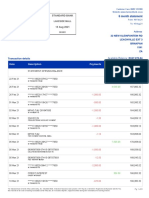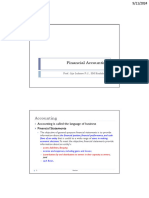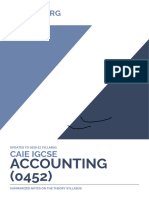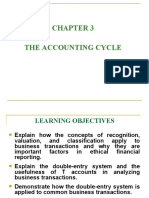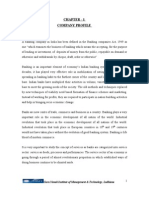POA
POA
Uploaded by
miracaronsCopyright:
Available Formats
POA
POA
Uploaded by
miracaronsCopyright
Available Formats
Share this document
Did you find this document useful?
Is this content inappropriate?
Copyright:
Available Formats
POA
POA
Uploaded by
miracaronsCopyright:
Available Formats
THE OR IE S
Role of accounting:Provides accounting information for stake holders to
make Informed decisions regarding the managementof resources
& performance of business.
Role ofaccountant: To prepare & provide
accounting information for decision
making. Accountants up
set an
accounting information system (Als) & become
stewards business.
of
PRO FESS 10 NAL E TH IC S
ethical accountant andis objective.
has
integrity
·
an
integrity:Straightforward & honestin all professional relationships.
objective:will notletbias, conflictofinterestor undue influence of others
override their professional judgement.
ACCOUNTING THE ORIES
accounting entity:activities of a business are separate from the actions of the
owner. All transactions are recorded from 400 of business.
accounting period:life of business is divided into regular time intervals.
TB, FS
consistency:once an accounting method is chosen, itshould be applied to all
NCA
<depreciations future accounting periods to enable meaningful comparison.
going concern:business is assumed to have indefinite economic life unless
TB, FS
there is a credible evidence thatmay close itdown.
historical cost:transactions shouldbe recorded atoriginal cost.
matching concept:expenses incurred mustbe matched againstincome earned
expenses
in the same period to determine profitof the period.
TR
A CC0 UNT, NG H50R
+
I ES
materiality concept:transaction is considered material ifitmakes a difference to
NCA(capital & revenue
expenditure)
decision-making process.
monetary:only business transactions thatcan be measured in monetary terms can be
recorded.
objectivity:Accounting information recorded must be supportedby reliable & verifiable
evidence so FS will be free from opinions & biases.
prudence concept:accounting treatmentchosen shouldbe the one that leastoverstates
inventory,
& leastunderstates liabilities & losses.
TR assets & profits
* accural basis of
accounting:
income, expense
* revenue recognition:
income
CASH US CREDIT TRANSACTIONS
is made
Cash: Payment atthe same time or immediately during a cash
sale I purchase.
credit: paymentis delayed or postponed during creditsale/purchase.
difference in the timing payment.
of
IS
A
accounting information system (AIS) is a system bussiness uses to collect, store,
& process accounting data. All has been computerised
source document:provides proof thattransactions have occurred.
b
journal:provide info to record in a journal.
↳ like a diary, daily record transactions organised by
↳
of
transaction dates.
ledger:posted individual
to ledgers accounts.
↳ consolidation ofall transactions relating to a specific ALICEitem.
trial balance:summary of ending balances of each ledger account
↳notrecorded/wrongly recorded will be adjusted by additional
journal entries which will be posted to
the ledger.
SF Performance:Provides reporton income, expenses & profit/loss
SFPosition:provides on
report assets, liabilities & equity.
SOURCEDOCUMENTS
Receipt:Acknowledges paymentreceived from customers immediately
after business sold goods/provided services.
Remittance:Informs creditsupplier payment
by cheque has been made
advice for a specif invoice.
Invoice:Informs creditcustomers of amount owed after the business sold
goods or provided services on credit.
credit note: Reduces amountowed creditcustomers
by who were previously
overcharged or have returned goods.
DebitNote:Increases amountowed by creditcustomers who were previously
under charged.
Paymentvoucher:processes paymentto creditsuppliers -> approved by authorised personnel
or
supportedby original
Supplier'sinvoice.
Bank Statement:Checks & tallies againstthe business records of its cab
account.
ACCO UNTING ELEMENTS
assets:resources a business owns or controls thatare expected to
provide future benefits.
liabilities:Obligations swed by business to others. Expected to be settled in
the future.
equity:claim by owner on of business.
the netassets
income:amounts earned through activities of business. (Revenue & other
incomel
expenses: costs incurred in operation of business to earn income.
accounting equ: Assets Liabilities Equity
+
-
expanded equ:assets Liabilities
: + (capital + (income -
expenses -
drawings)
double entry
each transaction will affectatleast 2 accounts.
atleastone will be debited
atleastone will be credited
DIS COUNTS
Trade disc: reduction to listprice
encourages cust to buy in bulk, their patronage & loyalty.
Cash diss:reduction to invoiced price
encourages creditcust to pay early within specifiedtime.
↳ discountallowed/discountreceived.
Revenue expenditure:
capital expenditure:
INTERNAL CONTROLS
0 F C A S H
segregation of duties:septrate cash handling & recording duties
among differentemployees so thatno
single person has
control over the entire cash process.
-receive & deposit
cash
-authorist invoices for & processes
payment payment to suppliers
-write authorise creants
custody ofcash:secure cash & cheques in a locked storage
-Limit
access of cash to authorised personnel
-provide combinations, passwords or other access codes to
authorised personnel
-
Deposit can daily into bank to minimise amount of cash
kept overnight business location.
at
Authorisation:obtain approvals for all payments from authorised
personnel
-Require atleast
two persons & approve all
to review
payments
Require valid supporting documents for all
payments
-
Bank reconciliation:Compare business' records with the bank's
records to identify items thatcaused the
differences between the ending balances in the
business cash & bank acc &I bank statement.
-
directdeposits -dishonoured cheques
-
direct
payments -errors made by business
-cheques yet
not presented or bank.
-
deposits in transit
You might also like
- Chase First StatementDocument3 pagesChase First StatementJason CoddingtonNo ratings yet
- Practice Question Basel III Liquidity Coverage RatioDocument21 pagesPractice Question Basel III Liquidity Coverage RatioBlack MambaNo ratings yet
- Chapter 2 The Accounting Equation and The Double-Entry SystemDocument24 pagesChapter 2 The Accounting Equation and The Double-Entry SystemMarriel Fate Cullano0% (1)
- Finacle 10 CommandDocument36 pagesFinacle 10 CommandPANKAJ MAHESHWARI100% (3)
- Synthesis ReviewerDocument10 pagesSynthesis ReviewerStela Marie CarandangNo ratings yet
- Fundamentals of Basic Accounting AlilingDocument9 pagesFundamentals of Basic Accounting AlilingEmil EnriquezNo ratings yet
- 32 New Kleinfontein RD Leachville Ext 3 Brakpan 1541 ZA: Standard BankDocument6 pages32 New Kleinfontein RD Leachville Ext 3 Brakpan 1541 ZA: Standard BankMECHANICAL ENGINEERINGNo ratings yet
- BAI2 SpecsDocument41 pagesBAI2 SpecsSrinath BabuNo ratings yet
- Basics of AccountingDocument42 pagesBasics of AccountingGgaurav KumarNo ratings yet
- Caie Igcse Accounting 0452 Theory v3Document23 pagesCaie Igcse Accounting 0452 Theory v3mujatitakundaNo ratings yet
- Caie Igcse Accounting 0452 Theory v3Document23 pagesCaie Igcse Accounting 0452 Theory v3tarzan.shakilNo ratings yet
- Class 2 PDFDocument17 pagesClass 2 PDFRajat AgrawalNo ratings yet
- EXAM REVIEWDocument22 pagesEXAM REVIEW1011197No ratings yet
- Review FinalDocument9 pagesReview FinalShrutika RuiaNo ratings yet
- Accounting PresentationDocument15 pagesAccounting Presentationilhambenlabsir99No ratings yet
- L2 Financial Reporting Concepts and Institutional Framework (Revised)Document50 pagesL2 Financial Reporting Concepts and Institutional Framework (Revised)wsxperryNo ratings yet
- FABM 2 Reviewer PrelimsDocument2 pagesFABM 2 Reviewer Prelimssushi nakiriNo ratings yet
- Acc 20short 20notesDocument42 pagesAcc 20short 20notesreyomen05No ratings yet
- Working Capital ManagementDocument38 pagesWorking Capital Managementprincebacolor8No ratings yet
- Actg121 Chpater 1 and 2Document26 pagesActg121 Chpater 1 and 2Jovern DiosoNo ratings yet
- akawntingDocument15 pagesakawntingtimothymark.castillo.cvtNo ratings yet
- Financial ManagementDocument1 pageFinancial ManagementJeff MargesNo ratings yet
- FABMDocument3 pagesFABMdanie.hermosaNo ratings yet
- Screenshot 2024-10-09 at 12.11.42 PMDocument26 pagesScreenshot 2024-10-09 at 12.11.42 PMSharlss CondezNo ratings yet
- AccountingDocument16 pagesAccountingy95255899No ratings yet
- Lecture Slides - Chapter 1 2Document66 pagesLecture Slides - Chapter 1 2Van Dat100% (1)
- FMA NotesDocument19 pagesFMA NotesLAXIANo ratings yet
- Conta GuiaDocument26 pagesConta Guiaronoel1546No ratings yet
- Far ReviewerDocument21 pagesFar Reviewerbea kullinNo ratings yet
- CHAPTER 3Document4 pagesCHAPTER 3npmonaresNo ratings yet
- Basic Accounting Handouts (LS 2)Document55 pagesBasic Accounting Handouts (LS 2)Yohanne MissNo ratings yet
- Far Reviewer 1Document13 pagesFar Reviewer 1Allyza May Gaspar0% (1)
- FABM (REVIEWER)Document27 pagesFABM (REVIEWER)Xyra OliviaNo ratings yet
- Local Media8011400976913649007Document16 pagesLocal Media8011400976913649007Ivan dela CruzNo ratings yet
- Definition of AccountingDocument27 pagesDefinition of AccountingAlexandra Nicole IsaacNo ratings yet
- Financial Accounting and ReportingDocument27 pagesFinancial Accounting and ReportingAlexandra Nicole IsaacNo ratings yet
- Fundamental Accounting ConceptsDocument35 pagesFundamental Accounting ConceptsHoney Jane Santiano BelenNo ratings yet
- Accounting ReviewerDocument6 pagesAccounting Reviewergrace antonette lopezNo ratings yet
- Accounting: Assets Liabilities + Equity A L + EDocument4 pagesAccounting: Assets Liabilities + Equity A L + EjermaineNo ratings yet
- Pdfcaie Igcse Accounting 0452 Theory v2 PDFDocument24 pagesPdfcaie Igcse Accounting 0452 Theory v2 PDFrumaisaaltaf287No ratings yet
- Chapter 2 The Accounting CycleDocument63 pagesChapter 2 The Accounting CycleMULATNo ratings yet
- Caie Igcse Accounting 0452 Theory v2Document24 pagesCaie Igcse Accounting 0452 Theory v2nothing12334343100% (1)
- Lecture Slides - Chapter 1 2Document69 pagesLecture Slides - Chapter 1 2Nhi BuiNo ratings yet
- Far Reviewer Lecture Notes 1 - CompressDocument21 pagesFar Reviewer Lecture Notes 1 - CompressAzure PremiumsNo ratings yet
- Caie Igcse Accounting 0452 Theory 6285a2ca279b4e2dd9daa14f 340Document23 pagesCaie Igcse Accounting 0452 Theory 6285a2ca279b4e2dd9daa14f 340medaaaf1No ratings yet
- Three Persons or Entities in The World of Commerce // Forms of Business OrganizationDocument16 pagesThree Persons or Entities in The World of Commerce // Forms of Business OrganizationChristian Joseph CantiladoNo ratings yet
- CHAPTER 3 Accounting Cycle (I)Document33 pagesCHAPTER 3 Accounting Cycle (I)Zemene HailuNo ratings yet
- Interpretation of Financial StatementsDocument41 pagesInterpretation of Financial StatementsEmmanuel MariscalNo ratings yet
- Chapter 2 Basic Financial StatementsDocument34 pagesChapter 2 Basic Financial StatementsJunaid Ashraf100% (1)
- Accounting: Assets Liabilities + Equity A L + EDocument4 pagesAccounting: Assets Liabilities + Equity A L + EJohn LeeNo ratings yet
- FR Prep Session (2) - 1-5Document38 pagesFR Prep Session (2) - 1-5mahachem_hariNo ratings yet
- Business Analysis and Valuation 3 4Document23 pagesBusiness Analysis and Valuation 3 4Budi Yuda Prawira100% (1)
- Part Two: Financial Accounting: An IntroductionDocument139 pagesPart Two: Financial Accounting: An IntroductionRobel Habtamu100% (1)
- Basic Accounting Prelim ReviewerDocument2 pagesBasic Accounting Prelim ReviewerEmily Joy BabanNo ratings yet
- ACT201 Chap001 NBNDocument18 pagesACT201 Chap001 NBNAudity PaulNo ratings yet
- BBAW2103 - Tutorial 1Document69 pagesBBAW2103 - Tutorial 1M THREE THOUSAND RESOURCESNo ratings yet
- Basic Aspects of Financial AccountingDocument12 pagesBasic Aspects of Financial Accountingsiva reddyNo ratings yet
- Basic AccountingDocument21 pagesBasic Accountingp.dashaelaineNo ratings yet
- What is Accounting Write Down a Short Note About Double Entry Accounting System (1)Document13 pagesWhat is Accounting Write Down a Short Note About Double Entry Accounting System (1)ekalabyaroy97No ratings yet
- Lecture 2 - Accounting The Language of BusinessDocument54 pagesLecture 2 - Accounting The Language of BusinessolgaszczechuraNo ratings yet
- Yotka AccountingDocument2 pagesYotka Accountingkarim.jamaleddine88No ratings yet
- Fundamentals of Accountin2Document5 pagesFundamentals of Accountin2Jessa GNo ratings yet
- Basics of Accounting Vol 1Document43 pagesBasics of Accounting Vol 1Priyanka HandaNo ratings yet
- Internal Control of Fixed Assets: A Controller and Auditor's GuideFrom EverandInternal Control of Fixed Assets: A Controller and Auditor's GuideRating: 4 out of 5 stars4/5 (1)
- CCS Application FormDocument14 pagesCCS Application FormNasif FarhanNo ratings yet
- Container Accounts: 3.1 The Nature of ContainersDocument8 pagesContainer Accounts: 3.1 The Nature of ContainersDada Temitayo EmmanuelNo ratings yet
- Calculation of The Liquidity Coverage RatioDocument2 pagesCalculation of The Liquidity Coverage RatiobedgamalNo ratings yet
- Wolf, M. (Financial Times) - Strip Private Banks of Their Power To Create Money (2014)Document12 pagesWolf, M. (Financial Times) - Strip Private Banks of Their Power To Create Money (2014)Sam SamNo ratings yet
- HDFC Bank Opening Savings Account Project ReportDocument85 pagesHDFC Bank Opening Savings Account Project ReportHarminder Singh50% (6)
- Filling Out FormsDocument20 pagesFilling Out FormsDanica Joy MendozaNo ratings yet
- 041123-SBI Analyst Presentation Q2FY24Document58 pages041123-SBI Analyst Presentation Q2FY24Madem Soma Sundara PrasadNo ratings yet
- SAB Corporate Know Your Customer Form - SABDocument9 pagesSAB Corporate Know Your Customer Form - SABwaee2lNo ratings yet
- El Detalle de Las TransferenciasDocument44 pagesEl Detalle de Las TransferenciasTodo NoticiasNo ratings yet
- M-Shwari Terms and ConditionsDocument10 pagesM-Shwari Terms and ConditionsdomomwambiNo ratings yet
- The Bank: Report On Habib Bank LimitedDocument45 pagesThe Bank: Report On Habib Bank LimitedEsha Ali ButtNo ratings yet
- Account Statement 100323 280323Document6 pagesAccount Statement 100323 280323Mainak BhattacharjeeNo ratings yet
- Amount Rs. This Forms Part of The PERSONAL LOAN Agreement Executed Between - Insert The NameDocument13 pagesAmount Rs. This Forms Part of The PERSONAL LOAN Agreement Executed Between - Insert The NameKapil KaroliyaNo ratings yet
- Esefa Final ResearchDocument50 pagesEsefa Final Researchbezaadane644No ratings yet
- Union Bank PDFDocument61 pagesUnion Bank PDFRakeshNo ratings yet
- Withdraw at An ATMDocument23 pagesWithdraw at An ATMAnonymous y3E7iaNo ratings yet
- Bcom Sem 3 M&F-1Document36 pagesBcom Sem 3 M&F-1Paresh LumbhaniNo ratings yet
- Rey Ocampo Online! FAR: Cash and Cash EquivalentsDocument3 pagesRey Ocampo Online! FAR: Cash and Cash EquivalentsMacy SantosNo ratings yet
- Fair Lend RulingDocument23 pagesFair Lend RulingJuan PeñaNo ratings yet
- Law 4Document2 pagesLaw 4Junho ChaNo ratings yet
- Statement 1Document190 pagesStatement 1amexem74No ratings yet
- Final-Examination Sample NHTM2 Tam-Update With-SolutionDocument3 pagesFinal-Examination Sample NHTM2 Tam-Update With-Solutionpthieuanh123No ratings yet
- Aman ProposalDocument25 pagesAman ProposalGetie TigetNo ratings yet
- DOBS Site Use Terms and ConditionsDocument21 pagesDOBS Site Use Terms and ConditionsAbel Keine LopezNo ratings yet
- Final Report of Vijaya Bank Part 2Document49 pagesFinal Report of Vijaya Bank Part 2shivangi shawNo ratings yet






